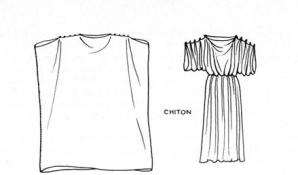So now that temperatures mimicking the seventh level of Hades are approaching I thought it might be a grand time to talk about Roman clothing. Done correctly, it is still several layers of foolishness… but if those layers are lightweight linen you’ll fare better in 95 degree weather with 70% humidity. #avoidheatstrokeifyoucan
For my basic 1st Century clothing I wear a tunic and palla combination as shown on statues of Agrippina the Younger. The palla as I wear it serves as a veil and/or shade from the sun.
- Tunica – A simple rectangular garment that could have sleeves or be sleeveless. It was the basic garment that went on under the stola. The chiton style is a large rectangular garment sewn together on the sides, held together over the shoulders by fibulae, and belted (top left illustration below). The peplos style does not have to be sewn up the sides. It is folded at the top,pinned with fibulae, and belted (bottom left illustration below).
- Stola – This was a garment worn only by matrons. The stola was worn under the palla and over the tunica. It was usually wool. The stola could be pinned at the shoulders, using the undertunic for sleeves, or the stola itself could have sleeves (sleeveless version shown in right side illustration below).
- Palla – The palla was a woven rectangle that the Roman matron put on on top of her stola when she went outside. She could use the palla in many ways, like a modern scarf, but palla is often translated as cloak (see right side illustration below).
More On The Basics (by Barbara McManus)
Similar to Roman men, the basic item of clothing was the tunic (tunica), though women’s tunics were fuller and longer, usually extending to the feet. There were two basic styles of tunic, both similar to tunics worn by Greek women.
The peplos was made from two rectangular pieces of cloth partially sewn together on both sides; the open sections at the top were then folded down in the front and back. The woman pulled this garment over her head and fastened it at her shoulders with two large pins, forming a sleeveless dress; she then tied a belt over or under the folds. This statue shows a Roman woman wearing a peplos and holding a glass vial for perfume.
The more common sleeved tunic worn by women was similar to the Greek chiton. Two wide pieces of cloth were sewn together almost to the top, leaving just enough room for armholes. The woman pulled this garment over her head and used several pins or buttons to fasten it at intervals over her shoulders and arms, forming a dress with sleeves which could be belted under the breasts, at the waist, or at the hips. The length of the sleeves was determined by the width of the cloth. Statues clearly show the manner of fastening the sleeves as well as various modes of draping and belting the tunic. Tunics could be brightly colored or made of lightweight fabrics such as linen or silk, as in this wall painting of a fashionable young woman pouring perfume into a tiny container.

At the time of her marriage, the Roman woman donned the stola, a long, sleeveless tunic, frequently if not always suspended at the shoulders from short straps, which was worn on top of another tunic. It is probable that the stola was typically made of undyed wool. The stola was a symbol of marriage, and by the late Republic all women married according to Roman law were entitled to wear it. Not all did, of course, since it was not a particularly fashionable or flattering garment, but wearing the stola was a way for a woman to publicly proclaim her respectability and adherence to tradition. Statues of the first empress Livia, for example, prominently display her stola, even this one whose head has been lost (a close-up clearly shows the strap of her stola).
Respectable women also wore a long cloak, called a palla, over their tunic and stola when they went outside. This was rectangular in shape and was typically draped over the left shoulder, under the right arm and back across the body, carried by the left arm or thrown back again over the left shoulder. The palla could also be pulled up to cover the head, as shown in the above statue of Livia or in this depiction of a matron whose elegantly draped palla has a fringe.
References:
Judith Lynn Sebesta &, Larissa Bonfante, The World of Roman Costume. Wisconsin Press (1994). ISBN 0-299-13854-2.
Leighton, Robert Fowler. A History of Rome. Harvard College (1878). Google Book.
McManus, Barbara F . Roman Clothing. The College of New Rochelle (2003).




